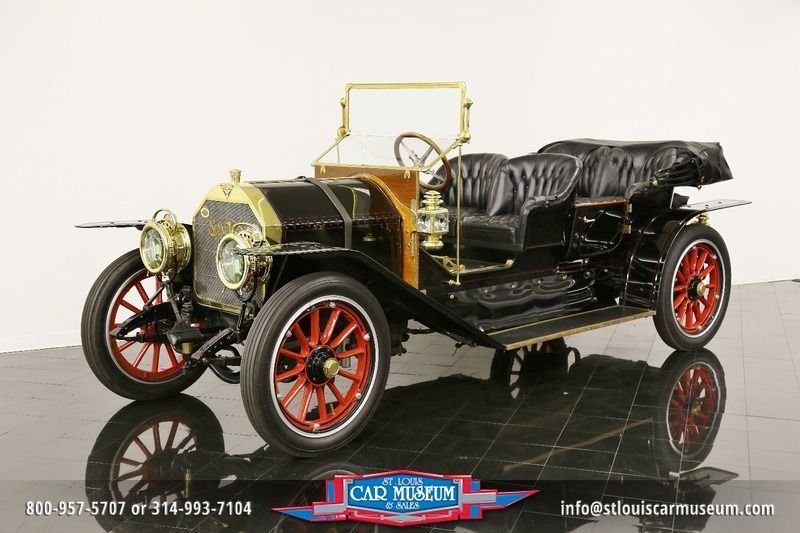Drivetrain
Chassis
Body

This 1912 Simplex Model-38, is powered by a four cylinder 40HP, T-Head motor with a CID of 476. 4-speed transmission. Exact replica body by Holbrook. This car runs and drives excellent. Complete with starter. Ready for touring!
Although the history of the mighty Simplex automobile is complicated, its reputation is not. The Simplex automobile is considered by automotive historians as one of the most significant cars built in America during the pre-World War I period. What set the automobiles built by Simplex apart from other American and European vehicles was the extreme attention to detail and quality. The Simplex automobile was one of the first true American sports cars. From the factory, they could be driven as powerful road going vehicles during the week and competitively raced on the track during the weekend. They were engineered to have the ideal power to weight ratios, which, in stock form, made them one of the most competitive American racing machines of the period.
This history of Simplex began when Proctor Smith and Carlton Mabley began importing fine European cars to New York early in the 20th century. In order to escape import duties, they embarked on the manufacture of an all-American car to rival the best that Europe had to offer. The cars were built in very limited quantities in a small, a five-story factory in Manhattan. Priced 6,000.00-or nearly ten-times the cost of a new, Model T Ford-the Simplex automobiles found homes with some of the most prestigious American families of the era. Like most expensive, luxury vehicles, the Simplex Company only built the chassis and the bodies were custom designed and built to the individual owners specifications. Bodies were supplied by esteemed coachbuilders such as Healey & Co., Demarest, Holbrook and Brewster.
This rare and desirable 1912 Simplex Model 38, car number 1150, is powered by a huge, four-cylinder, T-head engine with a cubic inch displacement of 476 and a conservatively rated horsepower of 40. Unlike most cars of the period, the Simplex Model38 was equipped with a four-speed, sliding gear transmission, which connects to the rear wheels via shaft drive. The wheelbase for the Model 38 is 127 inches. This example is fitted with an exact replica of a sporty and lightweight, four-passenger touring body originally supplied by the New York coachbuilder, Holbrook.
Today, this mighty Simplex is a charming and well-presented older restoration that looks right from all angles. It was restored in the late 1980s and by 1991 had earned its National First Place Senior Award by the Antique Automobile Club of America. It has been owned by a number of well-known collectors including William Lassiter of Florida and most recently, a well-known east coast collector of significant brass-era automobiles. The shining black paint and matching tufted leather seats are further defined by a careful red pinstripe that reveals every shape, curve and line of this majestic car. With its host of brass fittings, this car accurately portrays the style and luxury of its era. As an older restoration, black finish shows the expected of aging that one would expect from an early car that has been used and enjoyed. The diamond tufted leather interior is well preserved and has a nice, mellowed look to it. The folding black top shows the expected signs of wear, mainly from being folded as this car certainly begs to bedriven with the top down.
This car is well optioned with numerous, period brass accessories including a pair of large, gas headlamps with a proper, carbide generator, a complementing pair of sidelamps, a tail lamp, a bulb horn, a Jones speedometer and a folding windshield. Under the hood, the mighty, four-cylinder T-head engine is equipped with its Bosch magneto ignition system as well as a scarce and desirable period accessory Rushmore starting unit. The chassis and engine bay show the expected signs of cosmetic use that one would expect. At the time of the restoration, the artillery wheels were completely rebuilt for reliable touring. The chassis is equipped with period, accessory spring-loaded shock absorbers. It should be noted, that restoration of this Simplex was not simply aesthetic. The drivetrain was completely restored with the idea that this car would be used for long distance touring. After winning its AACA awards, this mighty Simplex completed several Brass & Gas and Horseless Carriage Club tours.
Today, this car is ready to continue its touring tradition and will offer its next owner the opportunity to lead the pack at any motoring events. Cosmetically, the car still shows extremely well and was recently invited and displayed at the Concours of America at St. Johns(formerly Meadowbrook). Simplex motorcars have always been held in high esteem by leading car collectors. It is estimated that less than a dozen Model 38 Simplexes have survived. They rarely become available and are highly sought after by major collections. Exceptionally rare and historically significant, this Simplex represents an excellent opportunity to own a top-quality example of a Brass Era automobile.

1912 Crane-Simplex
Model 38
Quick Specs
Description
This 1912 Simplex Model-38, is powered by a four cylinder 40HP, T-Head motor with a CID of 476. 4-speed transmission. Exact replica body by Holbrook. This car runs and drives excellent. Complete with starter. Ready for touring!
Although the history of the mighty Simplex automobile is complicated, its reputation is not. The Simplex automobile is considered by automotive historians as one of the most significant cars built in America during the pre-World War I period. What set the automobiles built by Simplex apart from other American and European vehicles was the extreme attention to detail and quality. The Simplex automobile was one of the first true American sports cars. From the factory, they could be driven as powerful road going vehicles during the week and competitively raced on the track during the weekend. They were engineered to have the ideal power to weight ratios, which, in stock form, made them one of the most competitive American racing machines of the period.
This history of Simplex began when Proctor Smith and Carlton Mabley began importing fine European cars to New York early in the 20th century. In order to escape import duties, they embarked on the manufacture of an all-American car to rival the best that Europe had to offer. The cars were built in very limited quantities in a small, a five-story factory in Manhattan. Priced 6,000.00-or nearly ten-times the cost of a new, Model T Ford-the Simplex automobiles found homes with some of the most prestigious American families of the era. Like most expensive, luxury vehicles, the Simplex Company only built the chassis and the bodies were custom designed and built to the individual owners specifications. Bodies were supplied by esteemed coachbuilders such as Healey & Co., Demarest, Holbrook and Brewster.
This rare and desirable 1912 Simplex Model 38, car number 1150, is powered by a huge, four-cylinder, T-head engine with a cubic inch displacement of 476 and a conservatively rated horsepower of 40. Unlike most cars of the period, the Simplex Model38 was equipped with a four-speed, sliding gear transmission, which connects to the rear wheels via shaft drive. The wheelbase for the Model 38 is 127 inches. This example is fitted with an exact replica of a sporty and lightweight, four-passenger touring body originally supplied by the New York coachbuilder, Holbrook.
Today, this mighty Simplex is a charming and well-presented older restoration that looks right from all angles. It was restored in the late 1980s and by 1991 had earned its National First Place Senior Award by the Antique Automobile Club of America. It has been owned by a number of well-known collectors including William Lassiter of Florida and most recently, a well-known east coast collector of significant brass-era automobiles. The shining black paint and matching tufted leather seats are further defined by a careful red pinstripe that reveals every shape, curve and line of this majestic car. With its host of brass fittings, this car accurately portrays the style and luxury of its era. As an older restoration, black finish shows the expected of aging that one would expect from an early car that has been used and enjoyed. The diamond tufted leather interior is well preserved and has a nice, mellowed look to it. The folding black top shows the expected signs of wear, mainly from being folded as this car certainly begs to bedriven with the top down.
This car is well optioned with numerous, period brass accessories including a pair of large, gas headlamps with a proper, carbide generator, a complementing pair of sidelamps, a tail lamp, a bulb horn, a Jones speedometer and a folding windshield. Under the hood, the mighty, four-cylinder T-head engine is equipped with its Bosch magneto ignition system as well as a scarce and desirable period accessory Rushmore starting unit. The chassis and engine bay show the expected signs of cosmetic use that one would expect. At the time of the restoration, the artillery wheels were completely rebuilt for reliable touring. The chassis is equipped with period, accessory spring-loaded shock absorbers. It should be noted, that restoration of this Simplex was not simply aesthetic. The drivetrain was completely restored with the idea that this car would be used for long distance touring. After winning its AACA awards, this mighty Simplex completed several Brass & Gas and Horseless Carriage Club tours.
Today, this car is ready to continue its touring tradition and will offer its next owner the opportunity to lead the pack at any motoring events. Cosmetically, the car still shows extremely well and was recently invited and displayed at the Concours of America at St. Johns(formerly Meadowbrook). Simplex motorcars have always been held in high esteem by leading car collectors. It is estimated that less than a dozen Model 38 Simplexes have survived. They rarely become available and are highly sought after by major collections. Exceptionally rare and historically significant, this Simplex represents an excellent opportunity to own a top-quality example of a Brass Era automobile.



